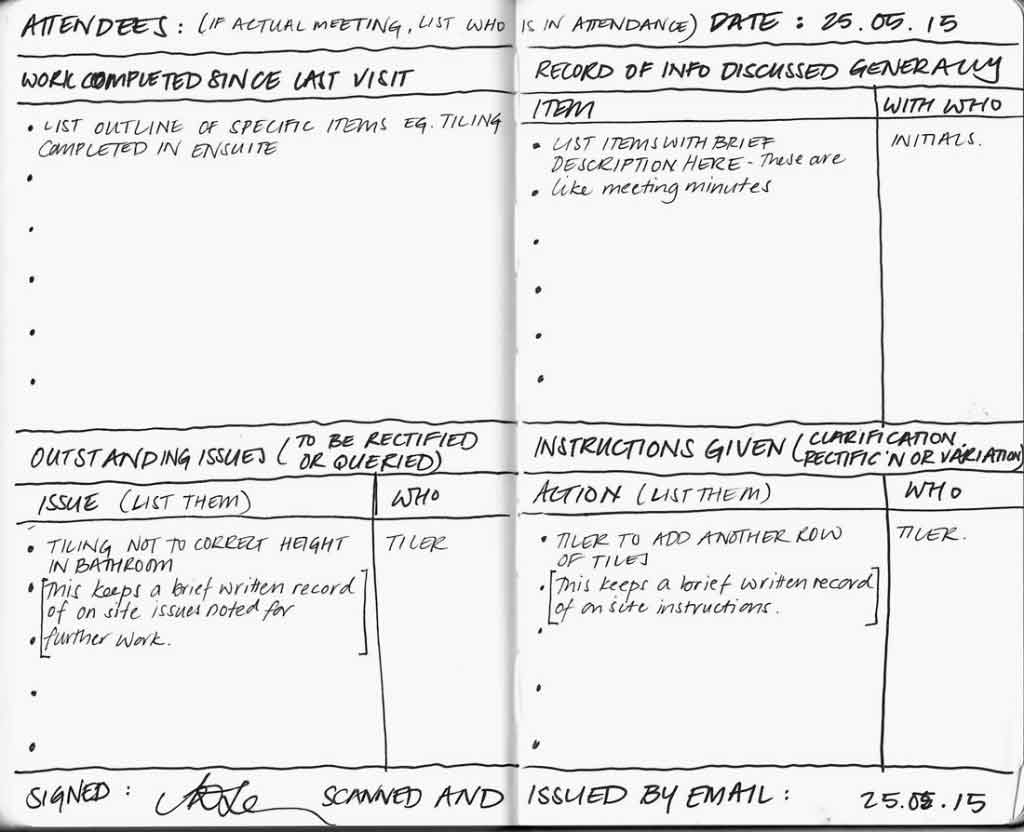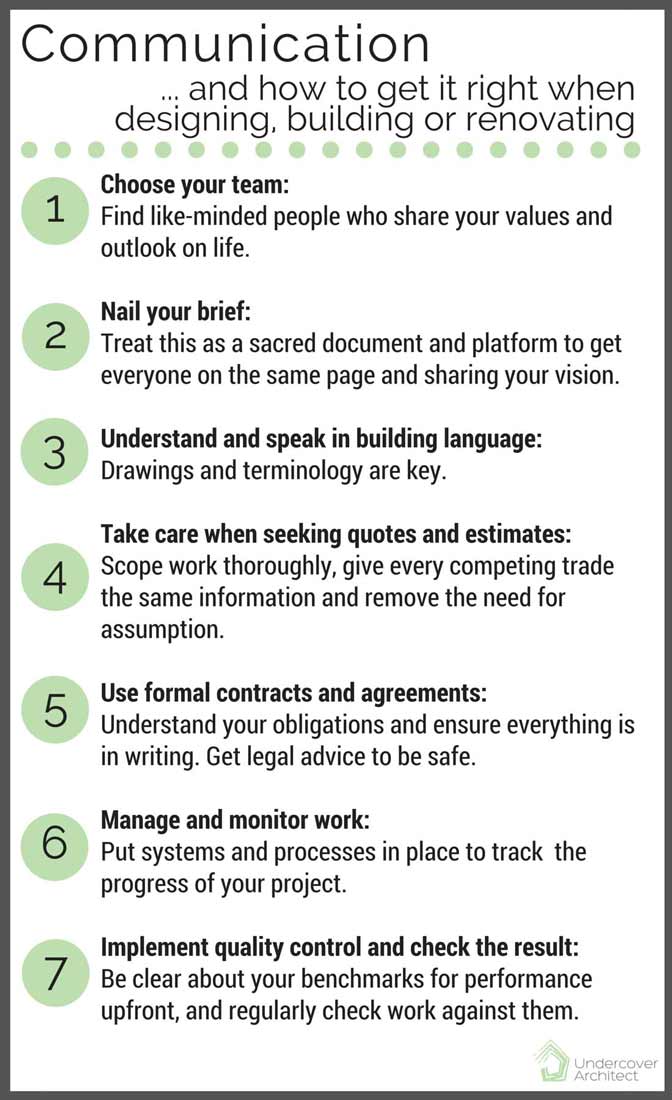
What is the tool we fail to use well when renovating or building?
Most disasters, nasty surprises, unexpected challenges and even just minor headaches, usually come down to the failure of one important tool. What is it?
Communication.
In the last blog, I posted the first half of this article I wrote for The Owner Builder’s June/July issue, titled “Communication – the key to a happy, successful project”. [Read first half here]. This is the second half, and outlines communication tools to use in the lead up to starting on site, and during construction.
[For Communication Tools 1 – 3, click here …]
Communication Tool 4: Seeking quotes and estimates
One important step where communication can lead to disaster is in how you seek estimates and quotes for your project. It’s usually where assumption leads to mistakes and surprises on site. Work to remove the need for assumption.
Whenever seeking quotes or estimates, put your information in writing. Scope out the work in detail, using supporting information (drawings, pictures, etc) where necessary.
Describing the finished result is a good way to explain and scope the work. If you tell someone how to do their work, you may miss the opportunity for them to offer their expertise and propose alternative methods that could save you time or money – and it’s always worth asking for this advice from them anyway.
Ensure you receive quotes and estimates in writing and give go-aheads for quotes in writing also. Keep records of all correspondence, as well as phone and verbal conversations. I find that simply writing it up as a note, and then emailing it to yourself and the other parties involved, is a great way to keep a record of it.
Communication Tool 5: Contracts and agreements
Always ensure you have formal, written agreements with everyone helping you deliver your project.
There are various standard contracts for building work – both as a whole, and the individual components and trades within it. If you are intimately involved in delivering your project as an owner-builder, I really recommend you get legal advice on what to expect, what your obligations are, and what these contracts mean.
It’s important too that you understand the various processes that can occur during a home build or renovation, and their implications contractually.
What, for example, happens with variations?
- Do they need to be advised and signed off in writing?
- How much warning do you or the tradespeople need to give to have them implemented?
- And will you have to pay them straight away, or at a milestone?
- What margin is added to them?
Most contracts will have some legislated requirements for processes such as these.
Communication Tool 6: Managing and monitoring work
It’s really helpful if you establish some systems in how you will manage and monitor work. This will depend on the scale of your project, and the pace at which it is being built, of course. However, see whether these methods could help you stay on track at your place.
- A construction program: helps you establish sequencing of trades and the timelines of each to complete their work. This helps you communicate to all involved how work will progress, and what needs to happen when.
- Regular site meetings: these are a communication hotspot, where issues can be raised, and any upcoming needs on site can be fleshed out. Take minutes (even if they’re handwritten notes), with a record of what was discussed, and action items agreed. Circulate to all involved and keep a record.
- Site instructions: any time you give an instruction to a tradesperson or professional that is outside, or in addition to, the arrangement you have with them, put it in writing. It helps you clearly articulate it, and provides a record to go back to should you need it.
- Site inspections: regular walk-arounds where work is inspected and compared to drawings / quotes / site instructions / contract to ensure it has been carried out in accordance with those things.
Don’t be overwhelmed if this seems like a lot. It may be as simple as having a dedicated notebook that you take to site with you every time you visit. The key is to have some discipline about record keeping, and monitoring work on your project. If something goes pear-shaped – whether during the project, or months after you’re finished – you do not want to be relying on your memory to sort it out. Written records are so essential in helping you get through your project smoothly.
Open to a two page spread, divide it into quarters, and then do something like this:
(I’ve written this in my notebook so you can see how it might work for you, but by all means, you may want to use different methods, headings and categories. The main thing is to create a system for recording activity on site, discussions and instructions – so you can track it and have it to refer to later. Dates and ‘who’ are especially important, and distributing the record to everyone too.)
Communication Tool 7: Quality control and checking the result
Expecting a certain type of quality and finish in your project (or parts of it) requires you stating those expectations upfront before work has been commissioned. So go back to Communication Tools 3 and 4 and make sure you capture this information during those steps of your project.
What’s important is that there is an understood framework, or benchmark, to which all those involved in your project know they are expected to perform to.
Some of those existing benchmarks include the National Construction Code, and the Australian Standards. You can hear me talk about the National Construction Code, including significant changes that were made from 2022 onwards, here on the podcast.
Where you believe work has not been carried out or completed to a required standard, communicate with fairness. It may have been a complete oversight by the person involved, and they’ll be more than happy to rectify it straight away. If you are not getting any results, then ensure you follow due process and communicate in writing. Refer to your state representative organisation to see what process you should follow when disputing building work. Communicate in the way you are required to and it will assist you in your case overall.
To wrap up …
“The single biggest problem in communication is the illusion that it has taken place.” – George Bernard Shaw
When undertaking your fantastic project, make sure you don’t leave anyone under any illusion as to whether communication has taken place! Exercise your “Communication Tools” every step of the way. Ultimately, this will help you deliver your project exactly as you envisage it.
For your ready-reckoner to summarise both this post/article, and Part 1 of this article, see the image below …
If you’ve found this useful or know someone it could help, please share or forward on.


 With over 30 years industry experience, Amelia Lee founded Undercover Architect in 2014 as an award-winning online resource to help and teach you how to get it right when designing, building or renovating your home. You are the key to unlocking what’s possible for your home. Undercover Architect is your secret ally
With over 30 years industry experience, Amelia Lee founded Undercover Architect in 2014 as an award-winning online resource to help and teach you how to get it right when designing, building or renovating your home. You are the key to unlocking what’s possible for your home. Undercover Architect is your secret ally
Leave a Reply